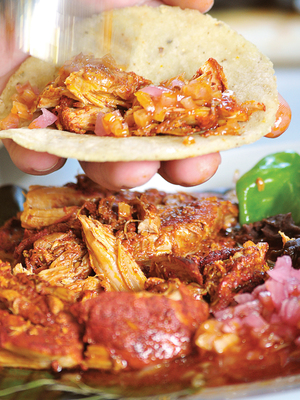While it's hard to find a person who doesn't at least like tacos, they don't always get the respect they deserve.
According to Déborah Holtz and Juan Carlos Mena, authors of Tacopedia, an impressive new tome, the taco is a focal point not just of Mexico's cuisine but of its culture, too.

The name of these tacos, "cochinita pibil," tells you what's inside: young pig cooked in an oven pit. It's a traditional Mayan dish that originated after the Spanish conquistadors arrived, bringing pigs with them.
"Mexicans eat them so often that the expression echarse un taco, to grab a taco, is synonymous with eating," they write. The phrase Le echas mucha crema a tus tacos, or "You add a lot of sour cream to your tacos," means that someone thinks a bit too highly of himself.
To celebrate this food, the authors spent four years exploring the culture, history and variations on the taco — defined simply as "a maize tortilla wrapped around food."
The final book, a best-seller in Mexico, has now been translated. With over 100 recipes, profiles of taco-makers, and eye-popping illustration and photography on every page, Tacopedia doesn't just teach readers to appreciate the taco — it makes them hungry, too.
Though people tend to concentrate on the fillings more than the wrap, there is no taco without the tortilla. And there would be no tortilla without the discovery of a process called nixtamal. By boiling maize in diluted lime (that's quicklime, not the green citrus) and letting the kernels stand overnight, the mixture gained enough malleability and cohesion "to hold a shape when mixed with water," something maize flour and cornmeal on their own cannot do. It also increased the tortilla's nutritional value by making more protein, calcium, and niacin available for human digestion. Today, "the poor spend almost ten percent of their food and drink budget on tortillas; the rich only 3.1 percent," Holtz and Mena write.
This process, and the taco itself, go back a long way. According to Holtz and Mena, "The taco was invented between 1,000 and 500 B.C. as a kind of edible spoon." Much like a spoon, the taco can hold a seemingly endless number of foods. Not counting the taco's cousins — enchiladas, quesadillas or tlayudas (kind of like a taco pizza that uses a fried or baked tortilla as the crust) — Tacopedia lists 16 variations on this dish.

A woman prepares tortillas at Kinich Restaurant in Izamal, Yucatan, Mexico. The average Mexican consumes 135 pounds of tortillas per year.
There are the familiar seafood tacos, the slow-cooked barbacoa (traditionally, lamb or mutton cooked overnight in an oven pit in the ground), the slow-cooked, shredded pork carnitas. For the more adventurous, the authors give an introduction to head-meat tacos and insect tacos: grasshoppers, white and red maguey worms, the jumil bug, or ant larvae. Then there are the varieties that depend on the way they're made or sold.

"One of the most famous dishes in Mexican cuisine," according to Tacopedia, carnitas tacos are made of pork meat, often fried in its own fat and then slow-cooked in a large pot.
Tacos de canasta, or basket tacos, for example, finish cooking after their seller heads out the door. In one method, the tacos are layered in a woven basket that's been lined with plastic to retain heat. The tacos are coated with pork rind fat, covered with raw onions and oil and then enclosed in the basket "so the tacos start to sweat," the authors write. Though there are many combinations of fillings, traditional ingredients include mashed potatoes, refried beans, pressed pork rinds, and various salsas and spices. They stay warm for hours and are a lunchtime favorite.
Though tacos may be Mexican in origin, there isn't an archetypal "Mexican taco." Visit Baja California and you might be treated to smoked marlin tacos. In Chiapas, try pito tacos, which Tacopedia describes as being "made with the flowers of the flame coral tree, fried in breaded patties, and served with red tomato broth." The small state of Querétaro might serve up beef crackling tacos, filled with beef offal and fried in pork lard. The neutral territory of the tortilla makes a welcoming home for the country's many regional specialties. Perhaps that's why for Mexico, the taco has become a defining dish.
9(MDE1MTIxMDg0MDE0MDQ3NTY3MzkzMzY1NA001))
300x250 Ad
300x250 Ad
